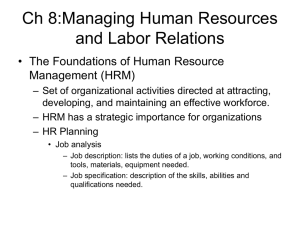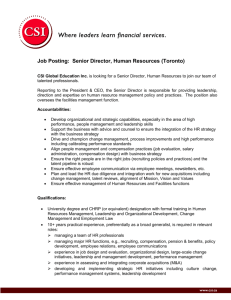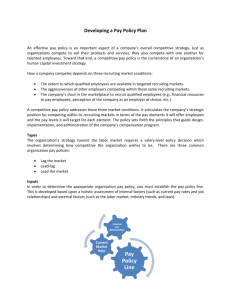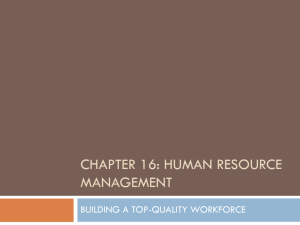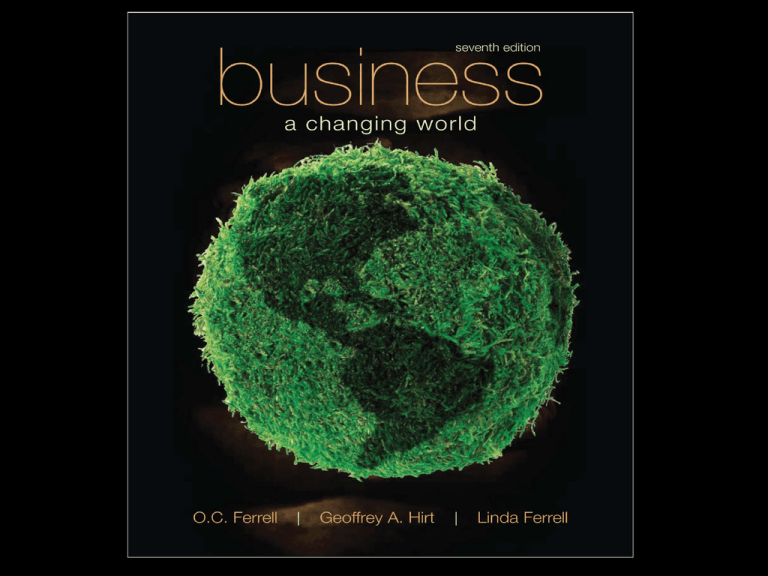
11-1
Business in a
Changing World
Chapter 11
Managing Human Resources
2
McGraw-Hill/Irwin
Copyright © 2009 by the McGraw-Hill Companies, Inc. All rights reserved.
11-3
Amadeus Consulting: Where
Employees are the Company
Lisa Calkins and John Basso have created a
company for which people are motivated to
work for the long term.
11-4
Managing Human Resources
Human Resources Management – all the
activities involved in determining the
organization’s needs for human resources and
acquiring, training, and compensating people to
fill those needs.
11-5
Managing Human Resources
HRM
Increasing in importance – Employee Concerns:
•Compensation
•Job satisfaction
•Personal performance
•Leisure
•Environment
•Opportunities for advancement
11-6
What is the Primary Reason you Accepted
Your Job?
35%
30%
25%
20%
15%
10%
5%
0%
Flexibility
Compensation Work Culture
Training
Advancement
Opportunities
Source: Snapshots, USA Today, March 13, 2008, p. B1
11-7
Planning – Human Resource Needs
•Job analysis – systematically determining pertinent
information about a job (tasks, abilities, knowledge, skills)
•Job description -- formal & written specifications of the job
(title, tasks, relationships, skills, duties, responsibilities).
•Job specification – description of the job qualifications
(education, experience, personal/physical characteristics).
11-8
Employee Recruiting & Selection
•Recruiting – the formation of a pool of qualified job candidates
from which management selects employees.
•Internal Sources
•Current employees
•Promotion from within
•External Sources
•advertising
•Employment agencies
•Online - Monster.com; Hotjobs.com
11-9
Employee Recruiting & Selection
•Selection – the process of collecting information about
applicants and using information to make hiring decisions.
•Application
•Interviewing
•Testing
•Reference Checking
11-10
Employee Recruiting & Selection
•Application --
•First stage of the selection process
•Name, address, telephone
•Education, previous work experience, references
•Qualifications for the position
11-11
Employee Recruiting & Selection
•Interview --
•2nd phase of selection
•Detailed information on candidate (applicant)
•Attitudes toward job
11-12
Employee Recruiting & Selection
•Testing --
•Ability and performance testing
•Aptitude, IQ, Personality tests
•Applicant assessment
•Goodness of “fit”
•Myers-Briggs Type Indicator
11-13
Employee Recruiting & Selection
Top 10 Interview Questions
11-14
Recruiting & Selecting Employees
Top 10 Mistakes Made in Interviewing
1. Not taking the interview seriously
2. Not dressing appropriately (dressing down)
3. Not appropriately discussing experience and education
4. Being too modest about one’s accomplishments
5. Talking too much
6. Too much concern about compensation
7. Speaking negatively of a former employer
8. Not asking enough or appropriate questions
9. Not showing the proper enthusiasm level
10. Not engaging in appropriate follow-up to interview
11-15
Employee Recruiting & Selection
•Reference Checking --
•Verifying education
•Previous work experience
•Privacy issues
11-16
Recruiting & Selecting Employees
Sampling of Psychological Tests
11-17
Legal Issues in Recruiting & Selection
Title VII of the Civil Rights Act -•Prohibits discrimination in employment
•Equal Employment Opportunity Commission (EEOC)
•Tests must be validated
11-18
Legal Issues in Recruiting & Selection
Laws affecting HRM -•Americans with
Disabilities Act (ADA)
•Age Discrimination in
Employment Act
•Equal Pay Act
11-19
Training & Development
Training -- teaching employees to do specific job
tasks through classroom development or on-the-job
experience.
Development – training that augments the skills
and knowledge of managers and professionals.
11-20
Training & Development
HiPiHi, Novo King, UOneNet – Stimulate new training concepts
11-21
Assessing Performance
Performance Assessment –
•Strengths
•Weaknesses
•Provides feedback
•Objective or subjective
•Quantitative or qualitative
11-22
Performance Characteristics
11-23
Turnover
Turnover – employees voluntarily leave (quit); involuntary leave
(fired). Management must replace workers.
Promotion – advancement to higher-level job with increased
authority, responsibility, and pay
Transfer – move to another job within the company usually at same or
similar level and wage rate
Separations – employment changes involving resignation, retirement,
termination, or layoff
11-24
Compensating the Workforce
Interesting job responsibilities
41%
Long-term potential
31%
Loyalty to the company
18%
Compensation
6%
Loyalty to manager
4%
Reasons Employees Stay in Their Current Jobs
11-25
Compensating the Workforce
Designing fair compensation plans
Wage/salary survey – study indicating how much
compensation comparable firms are paying for specific
jobs that firms have in common
11-26
Compensating the Workforce
Financial Compensation:
Wages – financial rewards based on hours
worked and/or level of output achieved.
11-27
Managing the workforce: Costco Versus Wal-Mart
Element
Costco
Wal-Mart
# of Employees
100,000 U.S.
137,000 (International)
1,420,000 U.S.
635,000 (International)
Sales
$64.4 billion
$378.79 billion
Average hourly wage
$17.25
$10.11
% of employees w/ health plans
82%
80%
Turnover (annually)
17%
40%
Profits per employee
$13,647
$11,039
11-28
Compensation
Piece wages – based on level of output
achieved. Motivate employees to increase
output.
Commission – incentive system that pays a
fixed dollar amount or a percentage of the
employee’s sales. Motivates employees to
sell as much as possible.
11-29
Compensation
Salary – financial reward calculated on weekly,
monthly, or annual basis. (White collar
employees, executives, professionals).
Bonuses – monetary rewards provided by firm for
exceptional performance or incentive to increase
productivity
11-30
Compensation
Profit sharing – a percentage of company
profits distributed to employees, sometimes
in the form of stock.
ESOP– Employee Stock Ownership Plan.
Company distributes shares to employees as
a form of compensation.
11-31
Best Entry-Level Salaries
Major
Salary
Computer science
$56,921
Electrical engineering
$56,429
Engineering
$56,336
Economics
$52,926
Nursing
$52,129
Chemistry
$52,125
Civil engineering
$49,427
Finance
$48,795
Accounting
$43,823
Business administration/management
$43,823
Political science/government
$43,594
Marketing
$43,459
Human resources
$40,250
11-32
Benefits
What are benefits?
Non-financial forms of compensation:
•Pension plans
•Insurance (health, disability, life)
•Child & elder care
11-33
Benefits
Bureau of Labor Statistics (2008)
Total compensation = $28.11 per hour
•Wages/salaries = 69.8%
•Benefits = 30.2%
•Taxes, FICA, etc = 7.9%
11-34
Benefits
EAP – Employee Assistance Program –
Counseling and assistance for employees’
personal problems that may negatively impact
job performance.
11-35
Fringe Benefits
Traditional Fringe Benefits
•
•
•
•
Sick leave
Pension plans
Health plans
Extra compensation (bonuses)
Soft Benefits Perks – work-life balance
•On-site child care
•Spas
•Food service
•Hair salons
11-36
Fringe Benefits
Cafeteria Benefit Plans – a set financial amount
allocated to employees which allows for selection
of benefits most appropriate to each employee
11-37
Managing Unionized Employees
Labor union – employee organization formed to
deal with employers for achieving better pay,
hours, and working conditions.
11-38
Managing Unionized Employees
Collective Bargaining – negotiation process where
management and unions reach agreement on wages,
hours, and working conditions for the bargaining unit
(employees represented by union).
11-39
Managing Unionized Employees
Labor contract – the formal, written document
that stipulates the relationship between union
and management for a specific time period. The
outcome of collective bargaining.
11-40
Unionized Employees
•12% of workforce
•Unionized workers earn more per hour
•Concentrated in certain industries
•automotive manufacturing
•steel production
•Construction
•Public-sector (government)
11-41
Collective
Bargaining
Process
11-42
Labor & Management Disputes
Pickets – public protests against the actions of the
company or management.
Strike – employee walkouts; work stoppage. Most
effective economic weapon for unions in private
sector.
Boycott – attempt to keep people form purchasing the
company’s products.
Lockout – management’s version of the strike. Worksite
is closed to prevent employees from working.
11-43
Outside Resolution of Disputes
Conciliation – 3rd party intervention so that
management & labor continue talks.
Mediation – 3rd party helps to bring labor
and management together to resolve
disputes
Arbitration – 3rd party settles dispute by
imposing solution that is legally binding
11-44
Workforce Diversity
11-45
Population by Race (in thousands)
Ethnic Group
Total
Increase 2000-04
Total population
293,655.4
4.3%
White
239,880.1
3.6%
Hispanic
41,322.1
17.0%
Black
37,502.3
5.7%
American Indian
4909.4
7.7%
Asian
13,956.6
16.2%
Native Hawaiian
976.4
7.7%
11-46
Benefits of Valuing Workforce
Diversity
• More productive use of human
resources
• Reduced conflict among employees
• More productive working relationships
• Increased commitment to
organizational goals
• Increased innovation and creativity
• Increased ability to serve the needs of
diverse customers
11-47
Affirmative Action
Legally mandated plans that try to increase job
opportunities for minority groups by:
•Analyzing the current pool of workers
•Identifying areas where women and minorities are
underrepresented
•Establishing specific hiring and promotion goals to
resolve the discrepancy.
Prohibits organizations from setting hiring quotas
that might result in reverse discrimination.
11-48

